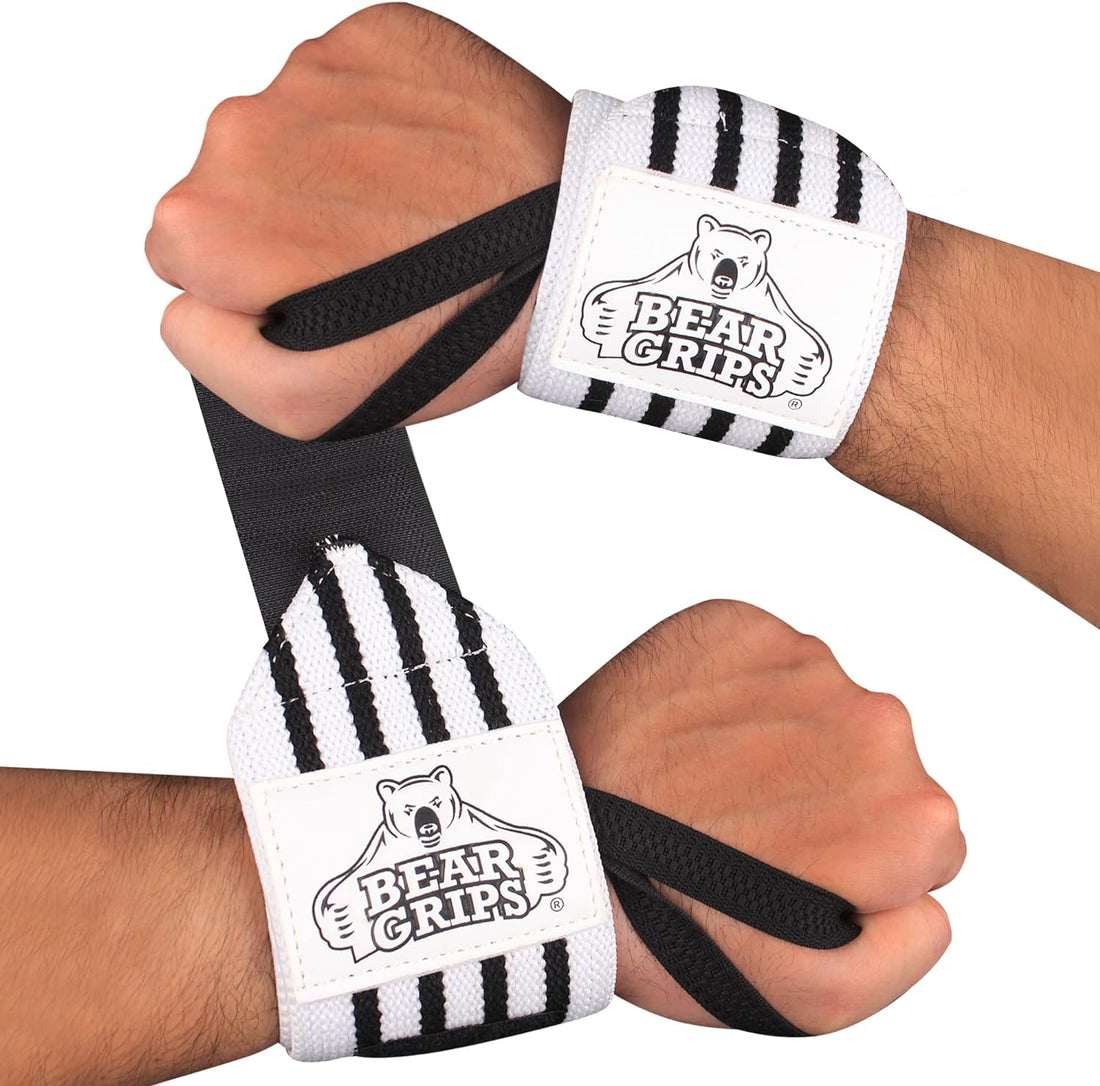
Wrist Straps vs Wrist Wraps: Differences and Benefits
Share
When it comes to weightlifting, proper form and technique are essential for achieving results and avoiding injury. One way to ensure that you are performing your exercises correctly is by using wrist support accessories like straps and wraps. While both wrist straps and wrist wraps serve a similar purpose, these two accessories are not interchangeable. Understanding which one to use can be confusing to beginners. In this article, we'll highlight the key differences between wrist straps and wrist wraps and their respective benefits to help you make an informed decision.

Key Takeaways:
- Wrist straps and wrist wraps offer different types of support.
- Wrist straps are best for exercises that require a strong grip, while wrist wraps provide stability and support to the wrist joint.
- Wrist straps are ideal for heavy lifting workouts, and wrist wraps benefit powerlifting exercises.
- The choice between wrist straps and wrist wraps depends on personal preference and fitness goals.
- Proper use and maintenance of both wrist straps and wrist wraps are essential to ensure their longevity.
What are Wrist Straps?

In the world of fitness, wrist straps are a popular accessory used to improve grip strength and provide additional support during heavy lifting. Wrist straps are typically made of durable materials, such as nylon or cotton, and come in a variety of sizes and styles to suit individual training needs. The primary function of wrist straps is to help individuals maintain a secure grip on weights that may be difficult to hold due to fatigue or other factors.
During weight training, an individual's grip strength can become a limiting factor in achieving their goals. This is where wrist straps can be beneficial, offering an additional layer of support that allows individuals to focus on lifting heavier weights without worrying about their grip failing. Additionally, wrist straps can help prevent injuries by reducing the risk of accidental drops or slips.
There are different types of wrist straps on the market, each designed to facilitate different types of training. Some wrist straps are specifically made for powerlifting, while others are better suited for weightlifting or bodybuilding. Choosing the right type of wrist straps can depend on individual training goals, the type of exercises performed, and personal preference.
Advantages of Using Wrist Straps
Wrist straps can be an invaluable tool for anyone looking to improve their heavy lifting game. With benefits ranging from improved grip strength to preventing injury, it's no wonder why so many weightlifters and powerlifters rely on wrist straps during their training sessions.
One of the most significant advantages of utilizing wrist straps is the added stability they provide during heavyweight training. By wrapping them around the barbell, weightlifters can maintain a firmer grip, even when lifting more massive weights. This increased stability not only helps lifters achieve new personal records but also reduces the risk of accidentally dropping weights, which can result in serious injury.
Another crucial advantage of wrist straps is that they can help prevent wrist injuries, particularly when performing exercises that place a lot of stress on the wrists. By offering additional support, wrist straps can help reduce the strain on the wrists and prevent common injuries, such as sprains and strains. This support is especially important for lifters who train regularly and put a lot of stress on their joints over time.
In addition to preventing injury, wrist straps can also help increase overall grip strength. By allowing lifters to utilize heavier weights for longer periods of time, wrist straps can help increase grip strength, which can have a positive impact on overall strength and performance.
Overall, the benefits of using wrist straps are numerous and varied. Whether you're looking to improve stability during heavyweight training or prevent injury, wrist straps are an incredibly useful tool for any serious weightlifter to have in their arsenal.
What are Wrist Wraps?
When it comes to weightlifting and other exercises that put stress on your wrists, wrist wraps are an essential tool. Providing stability and joint support, wrist wraps can help prevent injuries and improve your performance in the gym.
The main function of wrist wraps is to reduce the strain on your wrists by offering extra support and stability. This is especially important when you're lifting heavy weights or doing exercises that require a lot of grip strength. By keeping your wrists straight and properly aligned, wrist wraps can help you avoid common injuries such as sprains, strains, and tendonitis.
Wrist wraps are also helpful for people with weaker wrists, or for those who are recovering from an injury. By providing extra support, they can help protect your wrist joint and prevent further damage.
Another benefit of wrist wraps is that they can help improve your grip strength. By keeping your wrists straight and secure, you'll be able to grip the bar more tightly, reducing the risk of slippage and allowing you to lift heavier weights.
When choosing wrist wraps, it's important to consider the level of support you need and the type of exercises you'll be doing. Some wrist wraps offer more support than others, so if you're dealing with a previous injury or weakness in your wrists, you may want to opt for a higher level of support.
| Benefits | |
|---|---|
| Stability | Proper alignment and support for your wrists during heavy lifting and exercise. |
| Joint Support | Reduced risk of injury and strain on your wrist joint, helping to prevent further damage. |
| Prevent Injuries | Wrist wraps help prevent common wrist injuries such as sprains and strains. |
Overall, wrist wraps are a valuable tool for anyone serious about their training. By providing stability, joint support, and injury prevention, they can help improve your performance and keep you safe during even the most challenging exercises.
Benefits of Wearing Wrist Wraps
Using wrist wraps during weightlifting and powerlifting exercises can provide a range of benefits that enhance overall performance. Let's take a closer look.
Enhanced Stability
Wrist wraps provide additional stability during heavy lifts, making it easier to maintain proper form and protect against injuries. By reducing the range of motion in the wrist, wraps allow lifters to focus on the targeted muscle groups without worrying about wrist fatigue or strain.
Increased Power Output
Wearing wrist wraps can help increase power output during lifts, allowing lifters to reach their full potential. By allowing for a stronger grip, wraps help distribute weight more efficiently and stabilize the wrists for improved strength and endurance.
Reduced Risk of Injury
By providing additional support and protection to the wrists, wraps help reduce the risk of injury during weightlifting exercises. This is especially true when performing heavy lifts or exercises that put a lot of strain on the wrists.
Improved Confidence
Using wrist wraps can help lifters feel more confident during exercises, knowing that their wrists are protected and supported. This can be especially beneficial during heavy lifts, where fear of injury can cause hesitation and inadequate performance.
Customizable Fit
Wrist wraps come in a variety of sizes and materials, allowing for a customizable fit that meets the individual needs of each lifter. This ensures maximum comfort and support during workouts, improving overall performance and preventing wrist fatigue and strain.
Choosing the Right Option for You: Wrist Straps vs Wrist Wraps
When deciding between wrist straps and wrist wraps, considering personal preference and training goals is key. Both options offer benefits that can enhance your performance and improve your safety during workouts, so it's important to choose the option that best aligns with your individual needs.
For those looking to increase grip strength and support heavy lifts, wrist straps are a great choice. These durable straps wrap around your wrist and the bar, providing added stability and preventing slippage during exercises such as deadlifts and pull-ups.
On the other hand, wrist wraps are designed primarily for stability and joint support during heavier lifts. With a tighter fit than wrist straps, wraps are perfect for powerlifting exercises and can help prevent wrist injuries during bench presses and squats.
Ultimately, the choice between wrist straps and wrist wraps comes down to personal preference and training goals. Consider the specific exercises you'll be performing and the level of support and stability you need, and choose the option that will best help you achieve your fitness goals.
How to Use Wrist Straps vs Wrist Wraps Properly?
Wrist straps and wrist wraps are effective tools for enhancing your training and preventing injuries. However, to maximize their benefits, you need to use them correctly. Here are some techniques and dos and don'ts to ensure proper usage:
Correct Usage of Wrist Straps
- Wrap the strap around your wrist, ensuring a snug fit.
- Loop the loose end of the strap around the bar, with your palm facing down.
- Grasp the bar, maintaining a secure grip on the strap.
- Make sure to use wrist straps only during heavy lifting exercises, rather than all the time.
- Do not overuse wrist straps. They're meant to assist your grip, not replace it entirely.
Correct Usage of Wrist Wraps
- Wrap the wrist wrap tightly around your wrist, ensuring it is snug but not cutting off circulation.
- Use wrist wraps when performing exercises that place excessive pressure on your wrists.
- Ensure the wrap is positioned correctly, covering your entire wrist joint.
- Adjust the tightness of the wrap based on the exercise and personal comfort level.
- Do not rely entirely on wrist wraps to support your wrist. They're meant to enhance stability, not replace it entirely.
By following these techniques and dos and don'ts, you can ensure proper usage of wrist straps and wrist wraps, enhancing the effectiveness of your training and avoiding injuries.
Maintenance and Care Tips for Wrist Straps vs Wrist Wraps
Proper maintenance is key to ensuring the longevity of your wrist straps and wrist wraps. Here are some tips to help you take care of your gear:
Cleaning
Clean your wrist straps and wraps after each use to prevent the buildup of sweat, dirt, and bacteria. Use a gentle soap and warm water to clean them thoroughly. Avoid using harsh chemicals or bleach as they can damage the material and affect its performance. Hang dry your gear rather than machine drying it to help maintain its shape and elasticity.
Storage
Proper storage is also essential to keeping your wrist straps and wraps in good condition. Store them in a cool, dry place away from direct sunlight to prevent fading and deterioration. Avoid storing them in humid areas as moisture can cause mildew and unpleasant odors. Keep them in a protective case or bag to prevent damage from other equipment in your gym bag.
Longevity
With proper care and maintenance, your wrist straps and wraps can last for several years. However, it's essential to replace them once they start to show signs of wear and tear, such as fraying or losing elasticity, as they may no longer offer adequate support or protection, putting you at risk for injury.
By following these simple maintenance and care tips, you can help prolong the life of your wrist straps and wraps, ensuring they continue to provide the support and protection you need during your training sessions.
Conclusion
Wrist Straps vs Wrist Wraps are two essential tools for weightlifters and powerlifters looking to improve their performance and prevent injuries. While wrist straps offer support and grip strength during heavy lifting, wrist wraps provide stability and joint support. Choosing the right option depends on personal preference and training goals.
Regardless of which option you choose, proper usage is crucial to avoid potential injuries. Always follow correct techniques and dos and don'ts when using wrist straps and wrist wraps, and ensure to maintain and care for them properly to ensure their longevity.
Using Bear Grips wrist straps and wrist wraps into your training regimen can help take your performance to the next level, promoting optimal training and reducing the risk of injuries. So give them a try and see the difference for yourself!
Shop Now at Amazon.com.
FAQs
What are the differences between wrist straps and wrist wraps?
Wrist straps and wrist wraps serve different purposes. Wrist straps are mainly used to improve grip strength during heavy lifting exercises, while wrist wraps provide stability and support to the wrist joints during various movements.
What are the benefits of using wrist straps?
Wrist straps offer several advantages, including enhanced grip when lifting heavy weights, increased stability during intense workouts, and a reduced risk of wrist injuries.
How do wrist wraps help prevent injuries?
Wrist wraps provide support to the wrist joint, reducing the likelihood of injuries such as sprains and strains. They help maintain proper alignment and stability during weightlifting exercises, ensuring the wrists are protected.
Can I use wrist straps and wrist wraps simultaneously?
Yes, it is possible to use wrist straps and wrist wraps together. Some individuals prefer the added support and stability that comes from using both simultaneously, especially during heavyweight training.
How do I know which option is right for me?
Choosing between wrist straps and wrist wraps depends on personal preference and training goals. If grip strength is a primary concern, wrist straps may be more suitable. However, if you require additional wrist support and stability, using wrist wraps would be beneficial.
How should I use wrist straps and wrist wraps correctly?
To use wrist straps properly, loop the strap around your wrist and wrap it tightly around the bar or weight you are lifting. For wrist wraps, you should position the wrap around your wrist and secure it, ensuring it is snug but not overly tight.
What are some maintenance tips for wrist straps and wrist wraps?
To maintain wrist straps and wrist wraps, it is recommended to regularly clean them as per the manufacturer's instructions. Additionally, proper storage, such as keeping them in a dry and clean place, will help prolong their lifespan.

